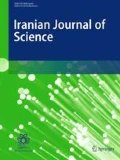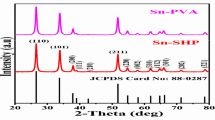Abstract
Previous studies show that ultrasound has a critical role in the synthesis of nanoparticles. In this paper, we compare the synthesis of MnO2 nanoparticles in the presence and absence of ultrasonic waves. The reaction efficiency is measured by the back titration method. The purity, phase, and morphology of the prepared samples are analyzed by X-ray diffraction (XRD) and field-emission scanning electron microscopy (FESEM). The surface area and total pore volume are measured by Brunauer–Emmett–Teller (BET) analysis. The results showed that the reaction efficiency reached 95% in the presence of ultrasonic waves during only 20 min, while it needed more than 6 h to reach such efficiency in the absence of ultrasonic waves. The XRD analysis and FESEM images showed that both samples were MnO2 nanoparticles and their phase was α. The increased synthesis rate is due to the production of free radicals during water sonolysis. Nitrogen adsorption–desorption isotherms displayed mesoporous nanoparticles with a pore size in the range of 2–10 nm for both samples. The surface area was 28.092 m2/g for samples under ultrasonic irradiation and 77.533 m2/g for other samples. A decrease of 2.75 times in the surface area was demonstrated for samples under ultrasonic irradiation. Also, the total pore volume of samples under ultrasonic irradiation was 1.85 times less than that of other samples. The reduction in the surface area and total pore volume is due to the role of the shock wave phenomenon in ultrasound irradiation. The shock wave increases the collision among nanoparticles and the adhesion among them. Based on the analysis of FESEM images, a new index is introduced describing the cohesiveness of the samples. This measure is compatible with the results of the BET analysis and shows increased adhesion among nanoparticles.






Similar content being viewed by others
References
Abulizi A, Yang GH, Okitsu K, Zhu J-J (2014) Synthesis of MnO2 nanoparticles from sonochemical reduction, of MnO4(−) in water under different pH conditions. Ultrason Sonochem 21:1629–1634
Ali GAM, Tan LL, Jose R, Yusoff MM, Chong KF (2014) Electrochemical performance studies of MnO2 nanoflowers recovered from spent battery. Mater Res Bull 60:5–9
Bolla MK, Choudhury HA, Moholka VS (2012) Mechanistic features of ultrasound-assisted oxidative desulfurization of liquid fuels. Ind Eng Chem Res 51:9705–9712
Dengchao W, Wang D, Huang Z, Zhao J, Cui G (2010) Fabrication of nanocomposite electrode with MnO2 nanoparticles distributed in polyaniline for electrochemical capacitors. Mater Chem Phys 124:1151–1154
Ebrahiminia A, Mokhtari-Dizaji M, Toliyat T (2013) Correlation between iodide dosimetry and terephthalic acid dosimetry to evaluate the reactive radical production due to the acoustic cavitation activity. Ultrason Sonochem 20:366–372
Ebrahiminia A, Mokhtari-Dizaji M, Toliyat T (2016) Dual frequency cavitation event sensor with iodide dosimeter. Ultrason Sonochem 28:276–282
Hajnorouzi A, Afzalzadeh R, Ghanati F (2014) Ultrasonic irradiation effects on electrochemical synthesis of ZnO nanostructures. Ultrason Sonochem 21(4):1435–1440
Kaneko K (1994) Review determination of pore size and pore size distribution 1. Adsorbents and catalysts. J Membr Sci 96:59–89
Kuppa R, Moholka VS (2010) Physical features of ultrasound-enhanced heterogeneous permanganate oxidation. Ultrason Sonochem 17:123–131
Li Z, Gu A, Lou Z, Sun J, Zhou Q, Chan KY (2017) Facile synthesis of iron-doped hollow urchin-like MnO2 for supercapacitors. J Mater Sci 52:4852–4865
Moghimi-Rad J, Zabihi F, Hadi I, Ebrahimi S, Isfahani T, Sabbaghzadeh J (2010) Effect of ultrasound radiation on the size and size distribution of synthesized copper particles. J Mater Sci 45:3804–3811
Mylarappa M, Venkata Lakshmi V, Vishnu Mahesh KR, Nagaswarupa HP, Prashantha SC, Siddeswara DMK, Raghavendra N (2016) Electro chemical and photo catalytic studies of MnO2 nanoparticle from waste dry cell batteries. Nanosyst Phys Chem Math 7(4):657–661
Nayak PK, Munichandraiah N (2012) Rapid sonochemical synthesis of mesoporous MnO2 for supercapacitor applications. Mater Sci Eng B 177:849–854
Okitsu K, Iwatani M, Nanzai B, Nishimura R, Maeda Y (2009) Sonochemical reduction of permanganate to manganese dioxide: the effects of H2O2 formed in the sonolysis of water on the rates of reduction. Ultrason Sonochem 16:387–391
Okitsu K, Iwatani M, Okano K, Helal Uddin M, Nishimura R (2016) Mechanism of sonochemical reduction of permanganate to manganese dioxide in aqueous alcohol solutions: reactivities of reducing species formed by alcohol sonolysis. Ultrason Sonochem 3:456–462
Raj BGS, Asiri AM, Qusti A, Wu QJ, Anandan S (2014) Sonochemically synthesized MnO2 nanoparticles as electrode material for supercapacitors. Ultrason Sonochem 21:1933–1938
Suslick KS, Price GJ (1999) Applications of ultrasound to materials chemistry. Annu Rev Mater Sci 29:295–326
Wei H, Wang J, Yang S, Zhang Y, Li T, Zhao S (2016) Facile hydrothermal synthesis of one-dimensional nanostructured α-MnO2 for supercapacitors. Phys E 83:41–46
Yang Z et al (2013) Different types of MnO2 recovered from spent LiMn2O4 batteries and their application in electrochemical capacitors. J Mater Sci 48:2512–2519
Zhang X, Duan Y, Guan H, Liu S, Wen B (2007) Effect of doping MnO2 on magnetic properties for M-type barium ferrite. J Magn Magn Mater 311:507
Author information
Authors and Affiliations
Corresponding author
Rights and permissions
About this article
Cite this article
Yaghoubi, P., Hajnorouzi, A., Rahmanifar, M.S. et al. Synthesis of MnO2 Nanoparticles in the Presence and Absence of Ultrasonic Irradiation. Iran J Sci Technol Trans Sci 43, 2619–2626 (2019). https://doi.org/10.1007/s40995-019-00702-8
Received:
Accepted:
Published:
Issue Date:
DOI: https://doi.org/10.1007/s40995-019-00702-8




